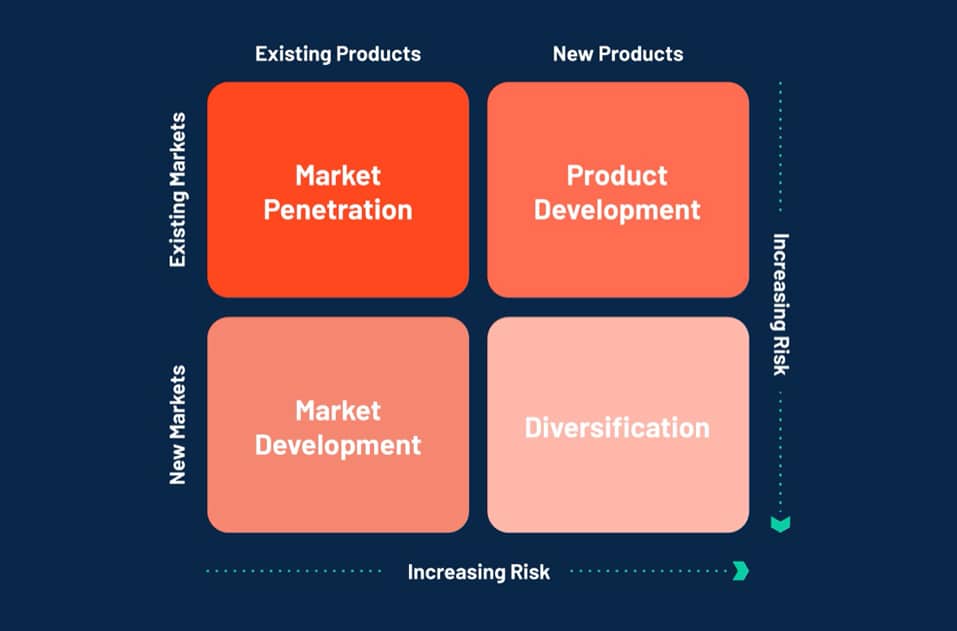
In the dynamic world of business, it is crucial to stay ahead of the competition and seize opportunities for growth.
The Market Product Grid is a valuable tool for any organization to systematically analyze and strategize its market growth efforts.
In this comprehensive guide, we’ll delve into the depths of the Market Product Grid, its various types, and how to create one.
Let’s begin our journey toward mastering this essential business tool!
Understanding the Market Product Grid

1. What is a Market Product Grid?
The Market Product Grid, also known as a market growth matrix.
It is a strategic planning tool that helps organizations evaluate and plan their growth opportunities by assessing their current products and markets.
By organizing products and markets into a grid, businesses can identify opportunities and devise strategies to expand, diversify, or strengthen their market position.
2. Importance of the Market Product Grid
The Market Product Grid allows businesses to:
- Identify growth opportunities
- Develop targeted marketing strategies
- Allocate resources efficiently
- Minimize risks associated with expansion
- Monitor and adjust strategies over time
3. Key Components of the Market Product Grid
A typical Market Product Grid consists of the following components:
- Products: Existing and potential offerings
- Markets: Current and prospective target markets
- Growth strategies: Specific approaches to achieve growth
Types of Market Product Grids

1. Ansoff Matrix
The Ansoff Matrix, also known as the Product-Market Growth Matrix.
Based on the relationship between products and markets, it classifies growth strategies into four quadrants:
- Market Penetration: Existing products in existing markets
- Market Development: Existing products in new markets
- Product Development: New products in existing markets
- Diversification: New products in new markets
2. Boston Consulting Group Matrix
The Boston Consulting Group (BCG) Matrix is a portfolio management tool that categorizes products or business units based on their market share and market growth rate.
The BCG Matrix consists of four quadrants:
- Stars: High market share in high-growth markets
- Cash Cows: High market share in low-growth markets
- Question Marks: Low market share in high-growth markets
- Dogs: Low market share in low-growth markets
3. GE-McKinsey Matrix
The GE-McKinsey Matrix, also known as the Nine-Box Matrix.
It is another portfolio management tool that evaluates a business’s products or units based on market attractiveness and business strength.
The matrix has nine cells, with different strategic implications for each cell.
Steps to Create a Market Product Grid

1. Identify Your Products and Markets
Begin by listing your existing products and target markets, along with any potential new offerings and markets you are considering entering.
2. Evaluate Growth Opportunities
Assess the growth potential of each product-market combination using relevant criteria, such as market size, competition, and profitability.
3. Develop Marketing Strategies
Based on your analysis, develop tailored marketing strategies for each product-market combination to capitalize on growth opportunities.
4. Allocate Resources
Allocate resources, such as budget and personnel, to each product-market combination based on its growth potential and strategic importance.
5. Monitor and Adjust
Regularly review your Market Product Grid to track progress, identify changes in the market, and adjust strategies as needed.
Strategies for Different Quadrants

1. Market Penetration Strategy
Market penetration aims to increase market share within existing markets by attracting competitors’ customers or encouraging current customers to purchase more.
Tactics may include price reductions, promotional campaigns, or product improvements.
2. Market Development Strategy
Market development focuses on introducing existing products into new markets.
Strategies may involve targeting new customer segments, expanding geographically, or leveraging new distribution channels.
3. Product Development Strategy
Product development involves launching new or improved products in existing markets.
This can be achieved through research and development, acquiring competitors’ products, or collaborating with other firms.
4. Diversification Strategy
Diversification entails entering new markets with new products.
It can be achieved through product innovation, acquisitions, or strategic partnerships.
Market Product Grid in Action: Real-Life Examples

1. Apple Inc.
Apple’s product development strategy led to the introduction of new products such as the iPhone, iPad, and Apple Watch, which have become successful within existing markets.
2. Amazon
Amazon exemplifies a diversification strategy by expanding from an online bookstore into various industries, including e-commerce, cloud computing, and entertainment.
Benefits and Limitations of the Market Product Grid

1. Benefits
- A systematic approach to identifying growth opportunities
- Facilitates resource allocation and strategic planning
- Encourages a balanced portfolio of products and markets
2. Limitations
- Simplistic and may overlook external factors
- Assumes a direct relationship between products and markets
- May not account for the unique characteristics of specific industries
Adapting the Market Product Grid for the Digital Age

1. Integrating Online and Offline Strategies
In today’s digital landscape, businesses must consider both online and offline strategies when using the Market Product Grid.
2. Leveraging Data and Analytics
Harnessing the power of data and analytics can help businesses make more informed decisions when using the Market Product Grid to devise growth strategies.
Conclusion
The Market Product Grid is an indispensable tool for businesses to systematically identify and capitalize on growth opportunities.
By understanding the various types of grids, creating a tailored grid, and developing appropriate strategies for different quadrants, businesses can optimize their market position and achieve sustainable growth.
As the business landscape evolves, adapting the Market Product Grid for the digital age and leveraging data and analytics will be crucial for continued success.
We are Yansourcing, a leading sourcing company in China, dedicated to helping our clients source products from China at the most competitive prices. If you are interested in importing from China, please feel free to contact us.
FAQs
1. What is the main purpose of the Market Product Grid?
The main purpose of the Market Product Grid is to help organizations systematically identify growth opportunities.
And develop targeted marketing strategies by analyzing their current products and markets.
2. Can the Market Product Grid be used for both small and large businesses?
Yes, the Market Product Grid can be applied to businesses of any size, as it provides a structured approach to evaluating growth opportunities and allocating resources.
3. What are the key differences between the Ansoff Matrix, BCG Matrix, and GE-McKinsey Matrix?
The Ansoff Matrix focuses on growth strategies based on the relationship between products and markets.
The BCG Matrix categorizes products or business units based on their market share and market growth rate.
And the GE-McKinsey Matrix evaluates products or units based on market attractiveness and business strength.
4. How often should a business update its Market Product Grid?
A business should regularly update its Market Product Grid to track progress, identify changes in the market, and adjust strategies as needed.
The frequency of updates may depend on the pace of change in the industry and the organization’s specific needs.
5. Can the Market Product Grid be applied to service-based businesses?
Yes, the Market Product Grid can be applied to service-based businesses by analyzing the services offered and their target markets, instead of physical products.
